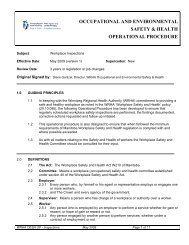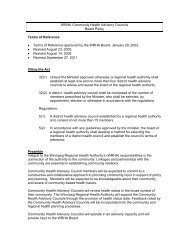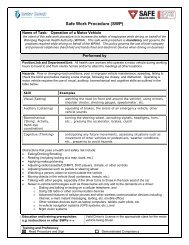Improving Primary Health Care Through Collaboration: Briefing 2 ...
Improving Primary Health Care Through Collaboration: Briefing 2 ...
Improving Primary Health Care Through Collaboration: Briefing 2 ...
- No tags were found...
Create successful ePaper yourself
Turn your PDF publications into a flip-book with our unique Google optimized e-Paper software.
For the exclusive use of Mona Lesage, mlesage@wrha.mb.ca, Winnipeg Regional <strong>Health</strong> Authority.6 | <strong>Improving</strong> <strong>Primary</strong> <strong>Health</strong> <strong>Care</strong> <strong>Through</strong> <strong>Collaboration</strong>: <strong>Briefing</strong> 2—October 2012practice (rural versus urban area), availability of specialtypractice and other health resources, and scope ofpractice of team members. 37 Little research has beencarried out on the optimal panel size for other healthprofessionals on an IPC team.Insufficient Space and Time forCommunication and <strong>Collaboration</strong>This section describes how the lack of physical spaceand time are significant barriers to IPC team optimization.The quantity and quality of interprofessional collaborationis related to the design of the physical space,whether there is co-location of team members, andthe amount of time available for team members toformally communicate.Physical SpaceLack of space has been reported as a barrier to collaborationin IPC teams. Gotlib Conn and others noted thechallenges faced by health care providers (HCPs) in anOntario family health team who were physically separatedfrom other team members: “The physical separation ofthe majority of physicians, nurses, clerical staff, andadministrators from the HCPs created a new symbolicbarrier that reinforced the perceived division betweenthe professions.” 38 An Ontario study by Oandasan andothers on the nature of interprofessional teamwork inthree academic family health centres that were evolvinginto family health teams found that both the quantity andquality of collaboration were strongly associated withspace and time. 39 The researchers noted that althoughphysicians, nurses, and clerical staff worked in physicalproximity in the study sites, some of the interprofessionalstaff (dietitians, behavioural science educators, socialworkers, occupational therapists, physiotherapists, pharmacists,and addiction counsellors) worked at a distancefrom one another. This distance presented a spatial impedi-37 Muldoon and others, “How Many Patients Should a FamilyPhysician Have?”38 Gotlib Conn and others, “Creating Sustainable Change inthe Interprofessional Academic Family Practice Setting.”39 Oandasan and others, “The Impact of Space and Time onInterprofessional Teamwork in Canadian <strong>Primary</strong> <strong>Health</strong><strong>Care</strong> Settings.”ment to communication and collaboration. 40 The studyparticipants noted that lack of co-location was the mainbarrier to interprofessional collaboration and that it furtheraggravated professional silos and the sense of exclusionfrom the core team. Lack of shared physical spaces thatare conducive to communication and collaboration werealso found to contribute to a lack of knowledge about theother professionals’ roles. As teams mature, co-locationmay not be as important as in the early stages, whenthere is a need to build team relationships and trust andto establish roles and responsibilities.This section describes how the lack of physical space andtime are significant barriers to interprofessional primarycare team optimization.Another barrier in terms of physical space is design andlayout of the space. Some participants in the study byOandasan and others believed that the informal, nonclinicaldesign of the space in which they were workingwould lead to greater cohesion and connectedness ofthe team, regardless of their professions. 41TimeOandasan and others also found that the way in whichclinical time was organized played an important role inthe quantity and quality of interprofessional collaboration.42 A prevalent observation across study sites, andone that is most probably the same experience acrossmost IPC teams, was that time pressures and constraintsresulting from patient care schedules make meaningfulcommunication between team members extremely difficult.The most common form of communication betweenteam members is informal, unstructured, and unplanned.The following section will further elaborate on thechallenge of inadequate communication in IPCteam optimization.40 Ibid.41 Ibid.42 Ibid.Find this briefing and other Conference Board research at www.e-library.ca
















